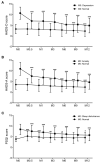Neuropsychiatric Adverse Events During 12 Months of Treatment With Efavirenz in Treatment-Naïve HIV-Infected Patients in China: A Prospective Cohort Study
- PMID: 33716807
- PMCID: PMC7943719
- DOI: 10.3389/fpsyt.2021.579448
Neuropsychiatric Adverse Events During 12 Months of Treatment With Efavirenz in Treatment-Naïve HIV-Infected Patients in China: A Prospective Cohort Study
Abstract
Background: Efavirenz (EFV) is widely used in antiretroviral therapy (ART), but the incidence and risk factors of neuropsychiatric adverse events (NPAEs) after EFV treatment have rarely been studied in Chinese ART naïve patients. Methods: This prospective cohort study assessed HIV-infected patients initiating antiretroviral treatment with EFV to determine prevalence of and factors associated with NPAEs over a 12-month follow-up period using the Hospital Anxiety and Depression Scale (HADS) and the Pittsburgh Sleep Quality Index (PSQI). Results: A total of 546 patients were enrolled. Prevalence of anxiety, depression, and sleep disturbances at baseline were 30.4, 22.7, and 68.1%, respectively. Six patients discontinued treatment due to drug related NPAEs. Treatment was associated with improvements in HADS-A, HADS-D, and PSQI scores over the 12-month follow-up, and the frequencies of patients with anxiety, depression, and sleep disturbances significantly decreased after 12 months. Abnormal baseline HADS-A, HADS-D, and PSQI scores and other factors, including high school education or lower income, unemployment, divorce, and WHO III/IV stages, were associated with severe neuropsychiatric disorders over the 12 months. Conclusions: These findings suggested EFV discontinuation due to NAPEs was low, and the HADS-A, HADS-D, and PSQI scores after 12 months of EFV treatment were associated with several risk factors. The clinicians should keep in mind and routinely screen for the risk factors associated with neuropsychiatric disorders in HIV-infected patients.
Keywords: antiretroviral therapy; anxiety; depression; efavirenz; sleep disturbances.
Copyright © 2021 Hua, Wang, Wang, Shao, Wang, Ye, Su, Jiang, Zhang, Wu, Liu, Li, Mahajan, Li, Sun and Dai.
Conflict of interest statement
The authors declare that the research was conducted in the absence of any commercial or financial relationships that could be construed as a potential conflict of interest. The reviewers SS and JC declared a shared affiliation with the authors SM and SW respectively, to the handling editor at the time of review.
Figures



Similar articles
-
Anxiety, depression, and sleep disturbances among people on long-term efavirenz-based treatment for HIV: a cross-sectional study in Beijing, China.BMC Psychiatry. 2022 Nov 16;22(1):710. doi: 10.1186/s12888-022-04366-4. BMC Psychiatry. 2022. PMID: 36384522 Free PMC article.
-
Neuropsychiatric Adverse Events Following Antiretroviral Therapy in People Living with HIV: A Real-World Study of Dynamic Trends and Risk Factors in Hangzhou, China.Infect Drug Resist. 2023 Aug 2;16:5007-5019. doi: 10.2147/IDR.S419308. eCollection 2023. Infect Drug Resist. 2023. PMID: 37551279 Free PMC article.
-
Pharmacodynamics of efavirenz 400 mg in treatment-naïve Chinese HIV-infected patients in a prospective cohort study.BMC Infect Dis. 2021 Jan 23;21(1):112. doi: 10.1186/s12879-021-05802-8. BMC Infect Dis. 2021. PMID: 33485301 Free PMC article.
-
Discontinuation of efavirenz therapy in HIV patients due to neuropsychiatric adverse effects.Scand J Infect Dis. 2013 Aug;45(8):645-51. doi: 10.3109/00365548.2013.773067. Epub 2013 Feb 21. Scand J Infect Dis. 2013. PMID: 23427878
-
Rolling out Efavirenz for HIV Precision Medicine in Africa: Are We Ready for Pharmacovigilance and Tackling Neuropsychiatric Adverse Effects?OMICS. 2016 Oct;20(10):575-580. doi: 10.1089/omi.2016.0120. Epub 2016 Sep 14. OMICS. 2016. PMID: 27627692 Review.
Cited by
-
Anxiety, depression, and sleep disturbances among people on long-term efavirenz-based treatment for HIV: a cross-sectional study in Beijing, China.BMC Psychiatry. 2022 Nov 16;22(1):710. doi: 10.1186/s12888-022-04366-4. BMC Psychiatry. 2022. PMID: 36384522 Free PMC article.
-
Outcomes of bictegravir/emtricitabine/tenofovir alafenamide versus efavirenz-based regimens in central China: a real-world assessment.Chin Med J (Engl). 2023 Nov 20;136(22):2738-2740. doi: 10.1097/CM9.0000000000002888. Epub 2023 Oct 25. Chin Med J (Engl). 2023. PMID: 37882080 Free PMC article. No abstract available.
-
Prevalence and associated factors of self-reported medical errors and adverse events among operating room nurses in China.Front Public Health. 2022 Dec 8;10:988134. doi: 10.3389/fpubh.2022.988134. eCollection 2022. Front Public Health. 2022. PMID: 36568794 Free PMC article.
-
Treatment persistence of bictegravir/emtricitabine/tenofovir alafenamide and efavirenz + lamivudine + tenofovir disoproxil among HIV-1 patients newly starting treatment in Hunan Province in China.BMC Infect Dis. 2023 Jun 12;23(1):396. doi: 10.1186/s12879-023-08359-w. BMC Infect Dis. 2023. PMID: 37308847 Free PMC article.
-
Mass Spectrometry Imaging Reveals Region-Specific Lipid Alterations in the Mouse Brain in Response to Efavirenz Treatment.ACS Pharmacol Transl Sci. 2024 Jul 9;7(8):2379-2390. doi: 10.1021/acsptsci.4c00228. eCollection 2024 Aug 9. ACS Pharmacol Transl Sci. 2024. PMID: 39156742 Free PMC article.
References
-
- WHO Guidelines Approved by the Guidelines Review Committee . Consolidated Guidelines on the Use of Antiretroviral Drugs for Treating and Preventing HIV Infection: Recommendations for a Public Health Approach. Geneva: World Health Organization; (2016). - PubMed
-
- Yeni P, Cooper DA, Aboulker JP, Babiker AG, Carey D, Darbyshire JH, et al. . Virological and immunological outcomes at 3 years after starting antiretroviral therapy with regimens containing non-nucleoside reverse transcriptase inhibitor, protease inhibitor, or both in INITIO: open-label randomised trial. Lancet. (2006) 368:287–98. 10.1016/S0140-6736(06)69074-0 - DOI - PubMed
LinkOut - more resources
Full Text Sources
Other Literature Sources

